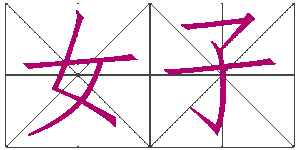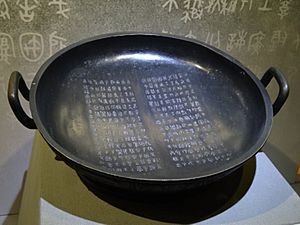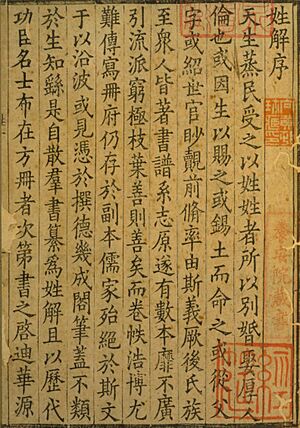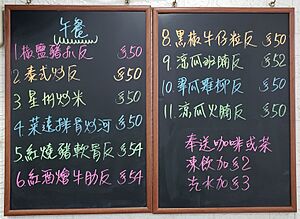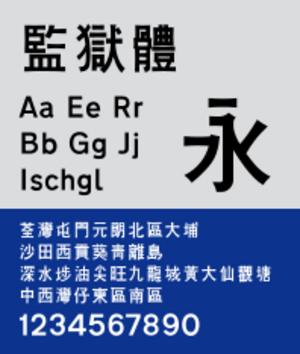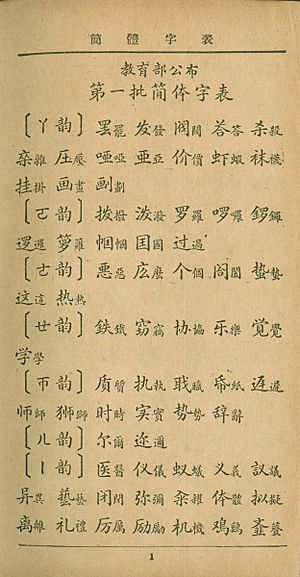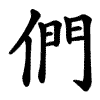Chinese characters facts for kids
Quick facts for kids Chinese characters |
|
|---|---|
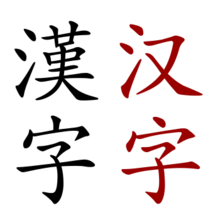
"Chinese character" written in traditional (left) and simplified (right) forms
|
|
| Type | Logographic |
| Spoken languages |
|
| Time period | c. 13th century BCE – present |
| Parent systems |
(Proto-writing)
|
| Child systems | |
| Unicode range | U+4E00–U+9FFF CJK Unified Ideographs (full list) |
| ISO 15924 | Hani |
| Note: This page may contain IPA phonetic symbols in Unicode. | |
| Chinese characters | |||||||||||||||||||||||||||||||||||||||||||||||||||||
|---|---|---|---|---|---|---|---|---|---|---|---|---|---|---|---|---|---|---|---|---|---|---|---|---|---|---|---|---|---|---|---|---|---|---|---|---|---|---|---|---|---|---|---|---|---|---|---|---|---|---|---|---|---|
| Chinese name | |||||||||||||||||||||||||||||||||||||||||||||||||||||
| Simplified Chinese | 汉字 | ||||||||||||||||||||||||||||||||||||||||||||||||||||
| Traditional Chinese | 漢字 | ||||||||||||||||||||||||||||||||||||||||||||||||||||
| Literal meaning | Han characters | ||||||||||||||||||||||||||||||||||||||||||||||||||||
|
|||||||||||||||||||||||||||||||||||||||||||||||||||||
| Vietnamese name | |||||||||||||||||||||||||||||||||||||||||||||||||||||
| Vietnamese alphabet |
|
||||||||||||||||||||||||||||||||||||||||||||||||||||
| Hán-Nôm |
|
||||||||||||||||||||||||||||||||||||||||||||||||||||
| Chữ Hán | 漢字 | ||||||||||||||||||||||||||||||||||||||||||||||||||||
| Zhuang name | |||||||||||||||||||||||||||||||||||||||||||||||||||||
| Zhuang | sawgun | ||||||||||||||||||||||||||||||||||||||||||||||||||||
| Sawndip | 𭨡倱 | ||||||||||||||||||||||||||||||||||||||||||||||||||||
| Korean name | |||||||||||||||||||||||||||||||||||||||||||||||||||||
| Hangul | 한자 | ||||||||||||||||||||||||||||||||||||||||||||||||||||
| Hanja | 漢字 | ||||||||||||||||||||||||||||||||||||||||||||||||||||
|
|||||||||||||||||||||||||||||||||||||||||||||||||||||
| Japanese name | |||||||||||||||||||||||||||||||||||||||||||||||||||||
| Kanji | 漢字 | ||||||||||||||||||||||||||||||||||||||||||||||||||||
|
|||||||||||||||||||||||||||||||||||||||||||||||||||||
Chinese characters are special symbols used to write the Chinese languages. They are also used in other countries that have been influenced by Chinese culture, like Japan and Korea. These characters have been around for over 3,000 years. They are one of the few writing systems that have been used continuously since they were invented!
Unlike letters in an alphabet that show sounds, Chinese characters usually represent whole words or parts of words that carry meaning. Because of this, you need to learn thousands of different characters to write a language fully. Characters are made in different ways. Their shape and even their sound can give clues about their meaning.
The very first Chinese characters were found on oracle bone inscriptions from around 1300 BCE. These were used by the Shang dynasty in what is now Anyang, China. At first, characters looked a lot like pictures. But over time, they changed to be easier to write. Later, during the Han dynasty (202 BCE–220 CE), a style called Clerical script made characters more abstract. This hid their original picture-like forms. After the Han dynasty, regular script became the main style.
Today, simplified characters are used in mainland China, Singapore, and Malaysia. Traditional characters are used in Taiwan, Hong Kong, and Macau.
Chinese characters were also used to write other languages in Asia. In Japanese, they are called kanji. In Korean, they are called hanja. In Vietnamese, they are called chữ Hán. These languages used existing characters for their own words and for words borrowed from Chinese. They also made new characters for local use. Today, Chinese characters are mostly replaced by alphabets in Korean and Vietnamese. This means Japanese is the main non-Chinese language still using them.
Characters are made up of small lines called strokes. These strokes are always written in a specific order. In the past, characters were carved into stone, or written with brushes on silk, bamboo, or paper. They were also printed using woodblocks and movable type. Now, we use computers and special input methods to write them.
Contents
How Chinese Characters Developed
Chinese characters are one of only four writing systems invented independently in human history. Writing systems usually started with simple pictures or signs. These early systems, called proto-writing, could not fully express spoken language.
For Chinese characters to truly become a writing system, some big changes happened.
- Pictures became symbols: For example, the character 大 meant 'large'. It used to be a picture of a large person. But it became a symbol that could be combined with other symbols. So, 大鹿 meant 'large deer', not a large person next to a deer.
- Simplification: Characters became simpler and more regular. This made them easier to write. Sometimes, it's hard to see what the original picture was.
- Sound clues: To write words that were hard to draw, people used a "rebus" technique. This is like using a picture of a "bee" to mean the letter "B". A character for one word might be used for another word that sounded similar. This helped write more words.
This process took a long time. When symbols only represented spoken words, the writing system was complete.
Types of Chinese Characters
Chinese characters are logographs. This means they represent units of meaning in a language, like words or parts of words. In Chinese, these units are usually single syllables. This is different from an alphabet, where letters represent sounds.
For a long time, people used a system from a dictionary called Shuowen Jiezi (written around 100 CE) to understand characters. This system had six categories, sometimes called the "six writings."
Picture-like Characters
Pictographs
Many of the oldest characters are pictographs. These are pictures of real objects. For example, 日 means 'Sun', 月 means 'Moon', and 木 means 'tree'. Over time, these pictures became simpler to write. So, it's often hard to tell what they originally looked like.
Indicatives
Indicatives are characters that show abstract ideas that don't have a physical form. Examples are 上 ('up') and 下 ('down'). These characters started as simple marks above or below a line. They changed to be clearer. Other examples include 凸 ('convex') and 凹 ('concave').
Compound Ideographs
Compound ideographs combine two or more characters to create a new meaning. For example, 明 ('bright') is made from ⽇ 'SUN' (Sun) and ⽉ 'MOON' (Moon). Together, they mean 'bright'. Another example is 休; 'rest', which combines ⼈ 'MAN' (person) and ⽊ 'TREE' (tree). This shows a person resting under a tree.
Sound and Meaning Characters
Phono-semantic Compounds
Most Chinese characters are phono-semantic compounds. These characters have two parts:
- A semantic component (meaning part) that gives a hint about the character's meaning.
- A phonetic component (sound part) that gives a hint about the character's pronunciation.
For example, 河; hé; 'river', 湖; hú; 'lake', and 流; liú; 'stream' all have three short strokes on their left side. This part, 氵, is a simplified form of 'water'. It tells you the character is related to water. The other part of each character gives a clue about its sound. For instance, the sound part of 湖; hú is 胡; hú, which sounds the same.
Sometimes, the sound part only gives a rough idea of the pronunciation. This is because sounds in spoken language have changed over time.
Borrowed Characters
Characters can also be borrowed to write other words that sound similar. This is called a loangraph. This happened a lot when Chinese writing first started. It is also used for words borrowed from other languages, like names of countries. For example, the characters for 加拿大; Jiānádà; 'Canada' are chosen because they sound like "Canada." Sometimes, the chosen characters also have a good meaning. For example, Coca-Cola's Chinese name is 可口可乐; 可口可樂; Kěkǒu Kělè, which means 'delicious enjoyable'.
History of Chinese Characters
Chinese characters have become simpler over time, both in how they look and how they are written. Old ideas that new styles suddenly replaced old ones are not true. Instead, different styles slowly changed and were used at the same time.
Early Stories of Invention
Ancient Chinese books say that people used knotted cords to keep records before writing was invented. One story says that Cangjie, a scribe for the legendary Yellow Emperor, invented Chinese characters around 3000 BCE. He was inspired by animal tracks and stars. When the first characters were made, grain rained from the sky, and ghosts cried because humans could no longer be tricked!
Neolithic Symbols
Scientists have found old symbols and pictures at ancient sites in China. These date back to around 6500 BCE. They were drawn on artifacts, but they were not yet a full writing system. They might be early forms of writing.
Oracle Bone Script
The oldest known Chinese writing is from the Late Shang period (around 1250–1050 BCE). Many of these writings are on oracle bones, which are animal bones or turtle shells. They recorded official predictions made by the Shang kings. This oracle bone script was first found in 1899. People were selling the bones as "dragon bones" for medicine! Later, the source was found near Anyang, China. Over 150,000 bone pieces have been found.
The Shang kings used these bones to talk to their ancestors. They asked about things like family, wars, and weather. The characters were carved into the bones. Even back then, people used a specific order to write the strokes. This oracle bone script is the direct ancestor of all later Chinese writing.
Zhou Dynasty Scripts
During the Shang dynasty, another style of writing was used for important things like bronze vessels. This is called bronze script. These characters were often less angular than the oracle bone script.
Over time, bronze script slowly changed during the Zhou dynasty (around 1046–256 BCE). It eventually became what we call small seal script.
Qin Dynasty and Small Seal Script
When the Qin dynasty united China in 221 BCE, the Qin small seal script became the standard writing style for the whole country. However, other simpler styles were also used by scribes.
Clerical Script
By the Warring States period (around 475–221 BCE), an early form of clerical script appeared. It became fully developed during the Han dynasty (202 BCE–220 CE). This style made characters simpler and more regular. They lost most of their original picture-like qualities.
Later, a simpler and faster form of clerical script appeared. This led to the development of regular script.
Cursive and Semi-Cursive Styles
Cursive script was used as early as 24 BCE. It used flowing brushstrokes. Later, a "modern cursive" style became popular, especially through the work of Wang Xizhi, a famous calligrapher.
Semi-cursive script appeared later in the Han dynasty. It's a faster way to write clerical forms. Strokes often flow together. This style is still common in handwriting today.
Regular Script
Regular script is the main style used for writing and printing characters today. It developed from clerical and semi-cursive forms. This style became very popular during the Northern and Southern period (420–589 CE). Later, during the Sui dynasty (581–618), people taking civil service exams had to write in regular script. This helped it become even more common.
How Characters are Built
Each character fits into a square space. Characters are made of individual strokes. Strokes are the basic lines you draw to form a character. There are rules for how to draw these strokes. For example, the character 永; yǒng; 'eternity' can show eight basic stroke types.
Characters are built in predictable ways. Some parts of a character might look different depending on where they are placed. The order in which you draw the strokes for a character is usually fixed. A general rule is to draw from left to right, then from top to bottom. If a character has an "enclosing" part, you start it, draw the inside parts, then close it.
For example, here's how to draw 永:
| Character | Stroke | |
|---|---|---|
| 1 | ||
| 2 | ||
| 3 | ||
| 4 | ||
| 5 | ||
Different Ways to Write Characters
Over time, characters can have different ways of being written, called variant character forms. These variants have slightly different shapes but mean the same thing. This is like how the letter "a" can look different depending on the font. Variants can appear for artistic reasons, to make writing easier, or to fix what people thought were mistakes.
For example, the character for 'bright' used to be written as 明 or 朙. Even though the Qin dynasty tried to standardize it, people kept using different forms. Eventually, 明 became the standard.
How Text is Arranged
From ancient times until the 20th century, Chinese texts were usually written vertically. Characters went from top to bottom in columns, and columns went from right to left. Today, horizontal writing (left to right, rows top to bottom) is more common, due to Western influence. But some publications still use the traditional vertical way.
Chinese writing usually does not use spaces between words. People understood the meaning from the context. Punctuation marks became common in the 19th and 20th centuries, also due to Western influence.
Ways to Write Characters
The first Chinese characters were carved into bones or marked in clay. People also wrote them with ink on silk, wood, and bamboo. Paper was invented around 1 CE. There are many styles, or scripts, for writing characters, like seal script and clerical script. Most of these styles started in China.
Calligraphy

Calligraphy is the art of beautiful handwriting. In China, it was one of the four main arts that scholars had to master. Chinese calligraphy usually uses an ink brush. Calligraphers can change character forms to create beautiful effects. They balance different ideas, like fast or slow strokes, or heavy or light ink.
Printing and Fonts
Woodblock printing was invented in China between the 6th and 9th centuries. Then, movable type was invented in the 11th century. Printing helped make character forms more standard.
Printed Chinese characters use different typefaces (fonts). There are four main types:
- Song or Ming typefaces: These are like Western serif fonts. They are traditional and often used for general printing.
- Sans-serif typefaces: These are called "black form" in Chinese and "Gothic" in Japanese. Their strokes are simple lines of even thickness.
- Kai typefaces: These imitate a handwritten style of regular script.
- Fangsong typefaces: These are like semi-script styles.
Using Characters with Computers
Before computers, devices like telegraphs and typewriters were made for alphabets. It was hard to use them for thousands of Chinese characters.
How to Type Characters
Most Chinese characters are typed on computers using a standard keyboard. Many methods let you type characters by their sound. For example, you can use pinyin for Mandarin Chinese. To type 香港; 'Hong Kong', you might type xiang1gang3
Other methods use the shape of characters. These can make typing faster. For example, the Cangjie input method uses parts of the character.
Computers can also guess which character you want based on what you've typed before.
Character Codes
The Unicode Standard is the main way characters are coded for computers worldwide. Each unique character gets a number. Unicode has over 98,000 Chinese characters!
How Characters are Used in Different Languages
Writing first appeared when the Chinese language was in its "Old Chinese" stage. Most characters matched single words. Classical Chinese was the written language used in old Chinese books. It was used for a long time, even as spoken Chinese changed. It was like how Latin was used in Europe.
Over time, Literary Chinese spread to countries like Vietnam, Korea, and Japan. People in these countries used Chinese characters for their own records and communications. Even though these languages are different from Chinese, they used characters to write their own words and words borrowed from Chinese.
In Japanese, Korean, and Vietnamese, characters can have both native readings and readings borrowed from Chinese. By the late 20th century, alphabets mostly replaced Chinese characters in Korean and Vietnamese. So, Japanese is the main non-Chinese language that still uses them.
Japanese Characters (Kanji)
In Japanese, Chinese characters are called kanji. Japanese people learned to read Chinese texts by changing the grammar and words to fit Japanese. When writing Japanese, kanji are used for words borrowed from Chinese and for native Japanese words that mean the same thing. Most kanji have both Chinese-based readings (on'yomi) and native Japanese readings (kun'yomi).
The Japanese writing system also uses syllabaries called kana. These are like alphabets, but each symbol represents a syllable. Kana were created by simplifying older kanji. Today, kanji are used for most word parts that carry meaning, while kana are used for grammar parts and borrowed words. Japanese also invented some of their own characters, called kokuji. For example, 峠 (tōge; 'mountain pass') combines characters for mountain, above, and below.
Korean Characters (Hanja)
In Korean, Chinese characters are called hanja. Koreans used hanja to write their own language, especially words borrowed from Chinese. Even though the hangul alphabet was invented in 1443, hanja were still used for a long time.
Many Korean words, especially technical ones, come from Chinese. Because Korean doesn't have tones, many words sound the same but have different meanings. Hanja helped show the difference. For example, 기사 (gisa) can mean more than 30 different things! Hanja helped clear up this confusion.
Here are some examples of hanja with their native Korean and Sino-Korean readings:
| Hanja | Hangul | Meaning | |
|---|---|---|---|
| Native translation | Sino-Korean | ||
| 물; mul | 수; su | 'water' | |
| 사람; saram | 인; in | 'person' | |
| 큰; keun | 대; dae | 'big' | |
| 작을; jakeul | 소; so | 'small' | |
| 아래; arae | 하; ha | 'down' | |
| 아비; abi | 부; bu | 'father' | |
Vietnamese Characters (Chữ Hán)
In Vietnamese, Chinese characters are called chữ Hán. They were used for all official writing in Vietnam for a long time. By the 15th century, a system called chữ Nôm was developed to write Vietnamese using adapted characters. Some chữ Nôm characters were made by combining two sound parts, which was unique.
Chữ Nôm was very complex, and not many people could read it. During the French colonial period, both Literary Chinese and chữ Nôm were replaced by the Vietnamese alphabet, which uses Latin letters. Today, the Vietnamese alphabet is the only official writing system in Vietnam.
Other Languages and Derived Scripts
Some minority languages in southern China also used Chinese characters. The sawndip script for the Zhuang languages is one example. Even though the Chinese government encourages using a Latin-based alphabet, sawndip is still used.
Other scripts were inspired by Chinese characters but did not use them directly. These include the Khitan small script and Tangut script. Nüshu was a script used by Yao women. Bopomofo is a system to represent the sounds of Standard Chinese, and its symbols come from Chinese characters.
Chinese characters were also used to write the sounds of other languages. For example, an old book called Secret History of the Mongols used Chinese characters to write the Mongolian language.
Learning and Dictionaries
To read and write well in languages using Chinese characters, you need to memorize thousands of them. This is different from phonetic writing systems that have fewer letters. People who are good at reading Chinese usually know 3,000 to 4,000 characters. Experts might know 5,000 to 6,000.
Dictionaries
There are about 15,000 characters in use today. Dictionaries organize characters in different ways. One common way is by radicals. Radicals are visually important parts of characters. The Kangxi Dictionary (1716) made a system of 214 radicals very popular. Dictionaries often group characters by their radical, then by the number of strokes. Some modern dictionaries also list characters by their pinyin spelling.
How Our Brains Read Characters
Scientists have studied how our brains read characters. Reading characters uses more parts of the brain, especially those for seeing. Even though you need to memorize many characters, knowing their sound and meaning parts helps a lot.
Changes and Standardization
Governments have often tried to change and standardize characters. This includes how they look, how strokes are ordered, and how they are pronounced. In the 1950s and 1960s, thousands of simplified characters were adopted in mainland China. Many of these were already common simpler forms. After World War II, Japan also simplified hundreds of characters.
The original, unchanged forms are called traditional characters. Today, mainland China, Malaysia, and Singapore use simplified characters. Taiwan, Hong Kong, and Macau use traditional characters. Most Chinese and Japanese readers can understand characters from all three systems.
In the early 1900s, many thinkers in China felt that the writing system was too hard. They wanted to make it simpler or even replace characters with an alphabet. They believed this would help more people learn to read.
Mainland China's Simplification
After the People's Republic of China was founded in 1949, the government continued to simplify characters. In 1956, they published a plan for simplified characters. In 1964, a revised list of 2,235 simplified characters was approved. Most of these came from old, simpler forms or common abbreviations. The goal was also to reduce the total number of characters. For example, 雲; 'cloud' and 云; 'to say' were merged into the simplified form 云.
A second round of simplifications was tried in 1977, but it was not popular and was stopped in 1986. These new forms were too different. After that, major character simplification largely ended. Today, the Table of General Standard Chinese Characters lists 8,105 characters.
Japan's Script Reform
After World War II, Japan also simplified some characters. These new forms are called shinjitai. Older forms are called kyūjitai. The government also made lists of characters for students to learn at each grade level. The main list today is the Jōyō kanji, which has 2,136 characters. There's also a list of characters allowed in names.
South Korea's Hanja Use
Hanja are still used in South Korea, but not as much as kanji in Japan. There's a trend to use only hangul (the Korean alphabet) in everyday writing. However, hanja are still seen in place names, newspapers, and to tell apart words that sound the same. They are also used in calligraphy.
Learning hanja in schools has been a debated topic. Students in middle and high school learn about 1,800 hanja to help them read newspapers.
North Korea's Hanja Use
North Korea tried to stop using hanja almost completely by 1949. But hanja are still an important part of education there. Students are expected to learn about 3,000 hanja by the time they finish university.
Taiwan's Traditional Characters
Taiwan's Ministry of Education published a list of 4,808 traditional characters in 1982. They also have dictionaries for characters used in different dialects like Taiwanese Hokkien and Hakka.
Other Regional Standards
Singapore simplified its characters in a few steps, eventually adopting the same simplified characters as mainland China. Hong Kong uses a list of 4,762 traditional characters for elementary and junior secondary education.
See also
 In Spanish: Caracteres chinos para niños
In Spanish: Caracteres chinos para niños





